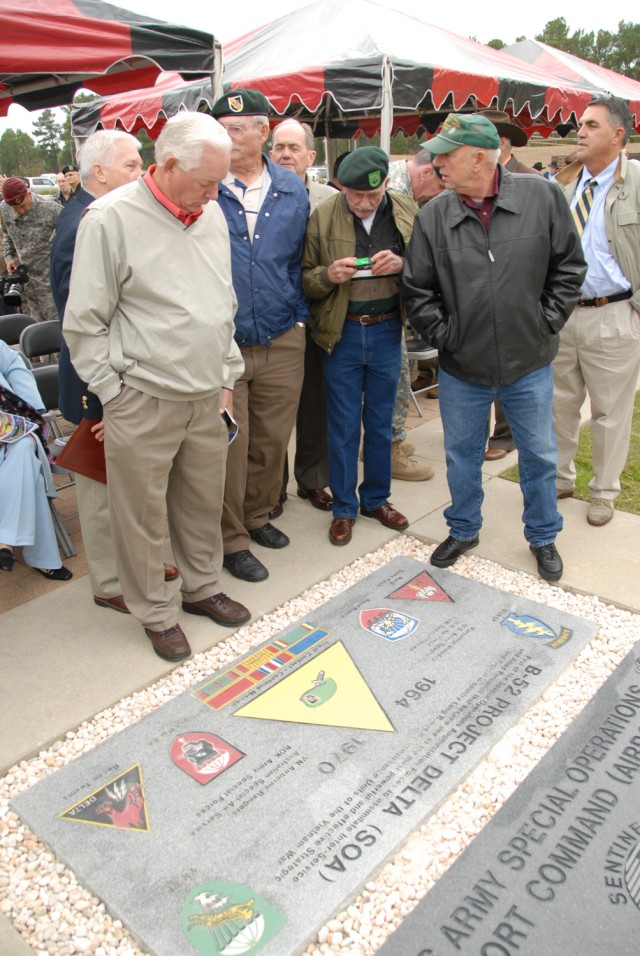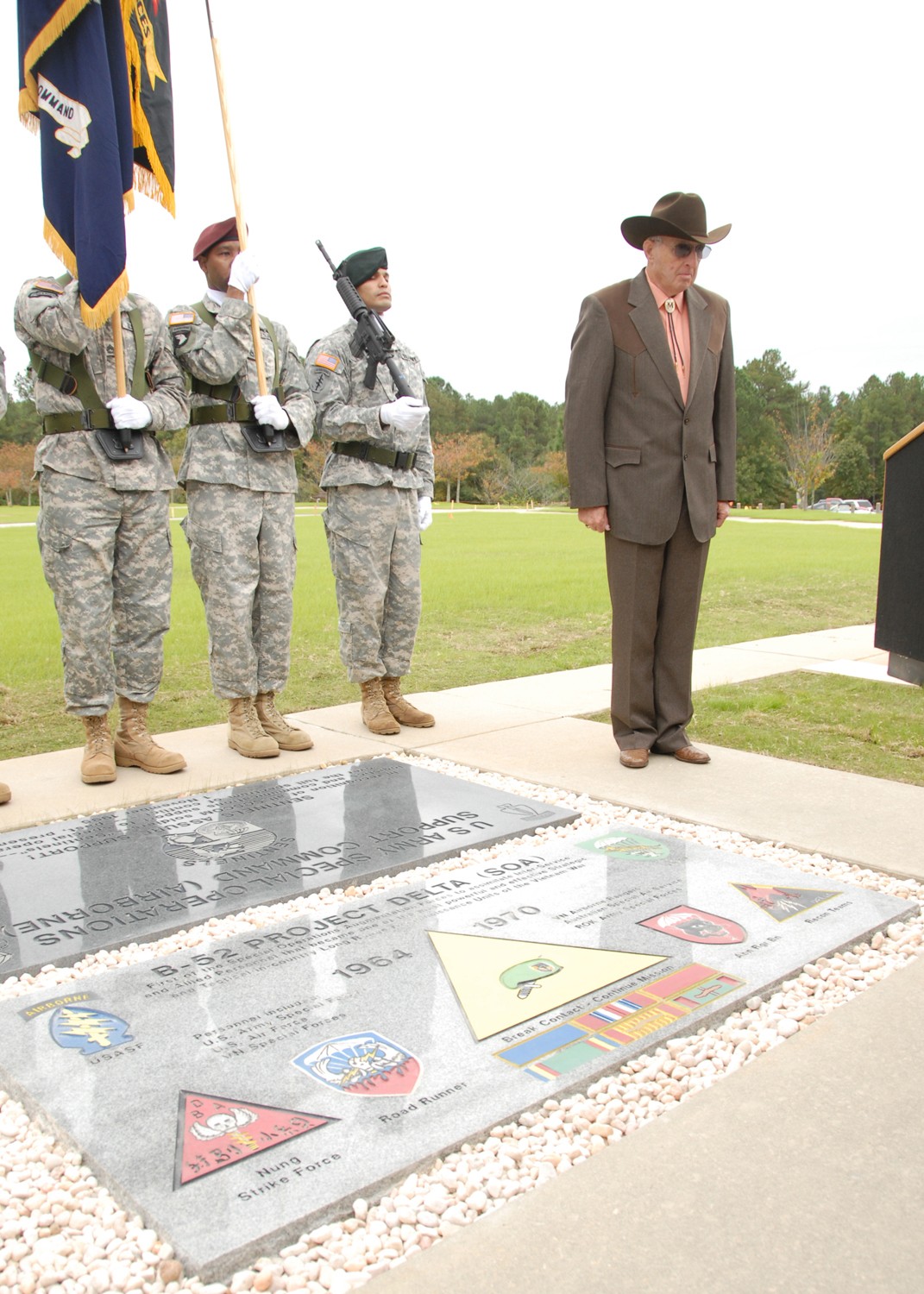FORT BRAGG, N.C. (USASOC News Service, Oct. 28, 2008) - One of the most decorated units in Special Forces history was honored by the U.S. Army Special Operations Command in a ceremony here, Oct. 24.
Project Delta, Detachment B-52, 5th Special Forces Group (Airborne), the most decorated single unit in the Vietnam War, had a memorial stone dedicated in their honor and placed in the Memorial Plaza at the USASOC headquarters. Lt. Gen. Robert W. Wagner, commanding general of USASOC, hosted the ceremony.
"Today we honor you, the members of this heroic unit in Vietnam," Wagner said. "Your accomplishments were invaluable. You operated at the tip of the spear before the term was coined."
Project Delta was a covert Special Forces operation in Vietnam which began May 15, 1964. A single SF detachment, B-52, was tasked with training the Civilian Irregular Defense Group and the South Vietnamese Special Forces, known as the Luc Luong Dac Biet, in conducting long-range reconnaissance patrols in uncontrolled and enemy territory.
The operation actually started as Project Leaping Lena in early 1964, which involved selected teams from the 1st Special Forces Group (Airborne) in Okinawa, Japan, and 7th Special Forces Group (Airborne) Fort Bragg, N.C.
"Like all great inventions, Leaping Lena, and later Project Delta, was created to solve a problem," said Alva D. Greenup, a retired Air Force colonel who served as a sergeant on a Project Delta recon team from 1967-1968. "The problem was we had many more times the area than there were troops to control it."
Tactically, Special Forces in Vietnam provided a valuable intelligence source, though they did not possess the offensive capability to project any real threat to the enemy, he said. Conversely, the divisions which were transferring into Vietnam had the offensive punch, but the enemy could frequently avoid major confrontations unless it was to their advantage.
"The enemy could act freely in the uncontrolled areas," Greenup said. "Something needed to be done to fix these problems in Vietnam, and that fix was Project Delta."
Shortly after the project's inception, the 5th SFG(A) began to take a more active role using B-52 as a command and control headquarters. Officially, it was organized into 12 recon teams consisting of 11 officers and 82 enlisted men from U.S. Special Forces. However, some people remember it slightly different.
"There's formal military history, and then there's war stories," Greenup said. "The real truth about what we were is somewhere in between. For instance, one thing, in my time there I never saw 12 recon teams. There just wasn't that many people."
In addition to the American Special Forces, there were more than 1,200 South Vietnamese and ethnic Chinese soldiers divided into two CIDG companies and the 81st South Vietnamese Airborne Ranger Battalion. One CIDG company was the Nung Strike Force, a platoon-size, rapid reaction force made up of ethnic Chinese soldiers. The other company was known as the Roadrunners.
The Roadrunners were select indigenous members from various groups, Greenup said. These soldiers showed an extra measure of courage in that they would go undercover within a North Vietnamese unit to provide intelligence. Once a North Vietnamese unit had been found, the Roadrunners would be prepped and fitted with the appropriate equipment, then inserted to link up with the enemy and collect information.
"As you can imagine, this was very hazardous duty," Greenup said. "These were some extraordinary people. It was always exciting when we were doing an extraction on a Roadrunner team. We'd go in on a helicopter and start picking up six guys out of the woods wearing North Vietnamese uniforms and carrying AK-47s. There were a lot of door gunners on helicopters that would like to have cut down on them."
Delta also incorporated several other support elements into the unit, including dedicated U.S. Air Force forward air controllers. These Airmen were an invaluable asset to the unit, and their skills came in handy as Project Delta enjoyed the highest priority in air support.
"When a Delta FAC called for air support they got it, and they got it very quickly," Greenup said. "That gave the recon teams a powerful wallop, and was an enormous confidence builder."
The 281st Assault Helicopter Company provided all the lift resources for Delta, while developing special tactics and techniques to enhance the mission of the ground forces.
"Every recon guy knew the 281st were coming to get 'em, no matter how bad the circumstances," Greenup said.
This sentiment was equally shared throughout Project Delta.
"It was said among the project that when the 281st came to get a Delta team on an emergency extraction, they would either get you out, or they would all crash beside you," said Gary L. Reagan, who served as a staff sergeant on a Delta recon team. "They wouldn't quit until one or the other had happened."
Delta was also the first U.S. Army unit in Vietnam to operationally assimilate U.S. inter-service and allied personnel, such as the Australian Special Air Service and the Republic of Korea Special Forces.
Although a variety of units were represented in Project Delta, the core mission surrounded the six-man recon teams.
"This was where we got the return on the investment," Greenup said. "The idea was inexpensive, efficient and turned out to be tremendously effective."
Originally the teams were made up of six Americans, but they eventually evolved into teams of two Americans and four indigenous personnel, typically Vietnamese Special Forces. As the effectiveness of the small recon teams evolved, other units were formed, such as Projects Gamma, Omega and Sigma. The Military Assistance Command Vietnam, RECONDO School was also developed from Detachment B-52 to train personnel in forming long-range recon patrol companies within each division.
These teams were designed to strike deep into uncontrolled territory, seeking out Viet Cong units and their sources of supply. Normally sent out on five-day operations, the teams performed a wide variety of missions, including locating enemy units, intelligence gathering, bomb damage assessment, artillery and air strike coordination, hunter-killer missions, special purpose raids, and conducting harassing and deception missions.
The project's success was directly due to the caliber of Soldiers serving in the unit and the shared professional ethos of the teams.
"In the finest tradition of Special Forces, almost every man seemed to be blessed with an inquiring mind, a strong will, an adventurous nature and a readiness to lead," Reagan said. "They approached the challenge with a very simple philosophy: we'll either find a way or make a way."
Despite being the most decorated unit in Vietnam, there were very few individual awards.
"There was almost a disdain for individual awards and recognition," Reagan said. "In Delta the standard was if you were dead, missing or seriously wounded you probably would be put in for a medal. If you came back in one piece, that was its own reward, and in a couple of days you could go out and do it again."
Spread across six years, Delta was small in numbers, yet it was big in impact. The intelligence gathered provided the identities of more than 70 NVA and VC units, enabling the capture of numerous supply caches, documents and prisoners. This information was often gained in remote and largely inaccessible areas of the counter and was produced with minimal casualties.
Although, as with any conflict, Project Delta did suffer its share of casualties. The names of 29 Delta members are inscribed on the Vietnam Veteran's Memorial Wall in Washington, D.C.
Delta was officially deactivated on July 31, 1970, and the men of Detachment B-52 went their separate ways. During its six-year history, roughly 600 Soldiers served with the unit. Many of them continued on in military careers, some becoming instructors for various schools, and others returning to the Special Forces groups to pass on valuable lessons from their Project Delta experience. One Delta member wrote and published a 'tricks of the trade' manual.
"Rumor has it that this book is still used among present-day Special Forces guys," Greenup said. "We're quite proud that the legend lives on with the new guys."
Of the Delta members who stayed in the military, 20 became field-grade officers, two became general officers, including former chairmen of the joint chiefs of staff Gen. Hugh Shelton, and 59 became command sergeants major.
"Delta attracted men from all walks of life, and when their time in the project was over they moved on to contribute to their communities and country in many ways," Reagan said.
Several of the men went on to become physicians, professors and ministers. Others went into areas as varied as law enforcement, television broadcasting and nuclear power.
Most importantly to many of the Delta members, is that their legacy lives on in modern-day Special Forces.
"I'm confident that the Project Delta members had a great deal of influence regarding the development of the modern Special Forces tactics," Greenup said. "The legacy of Project Delta is partly due to the extraordinary six-year history in Vietnam, and partly due to the success of Special Forces teams carrying on the fight to our nation's enemies in Afghanistan and Iraq, and throughout other locations in the world."
For many, Project Delta set the standard for those Special Forces Soldiers who came after them.
"You set the example and established the blueprint of the things we do today, for all the future generations of Special Operations Forces," Wagner said. "You were young men with the skills, courage and trust in one another to put your life at risk, with the instincts and cunning judgment to know what to do. No bragging, no boasting, just doing. Without the technology we have today, but with the simple courage, guts and tenacity to never quit."








Social Sharing